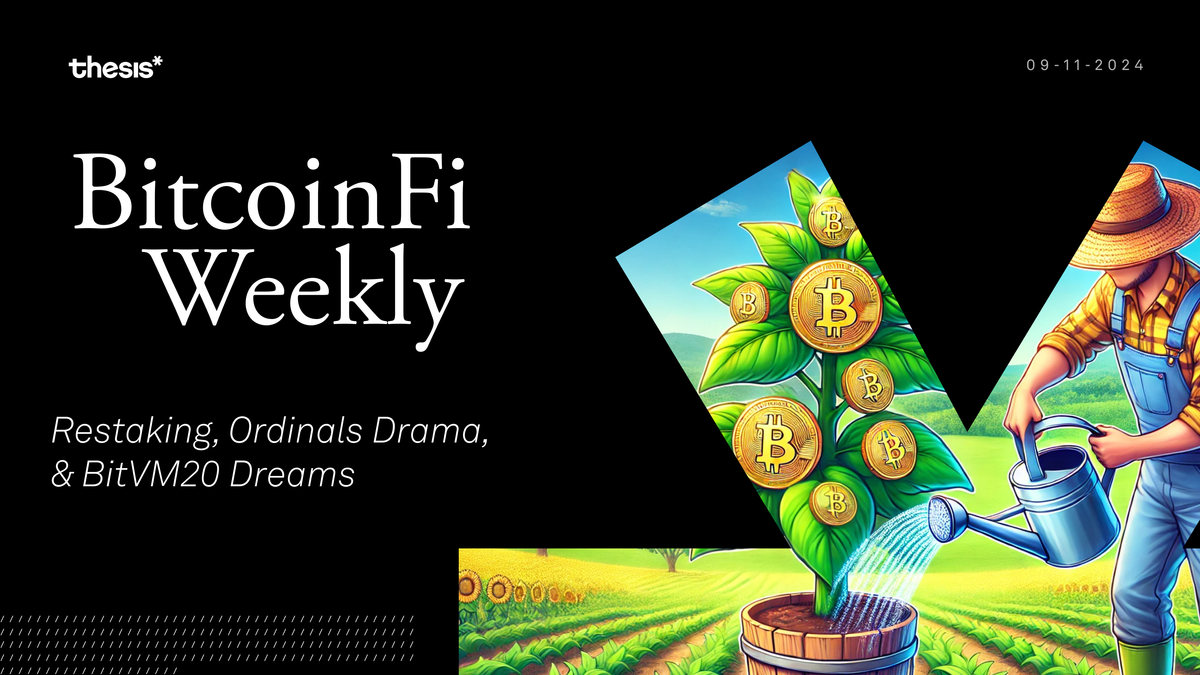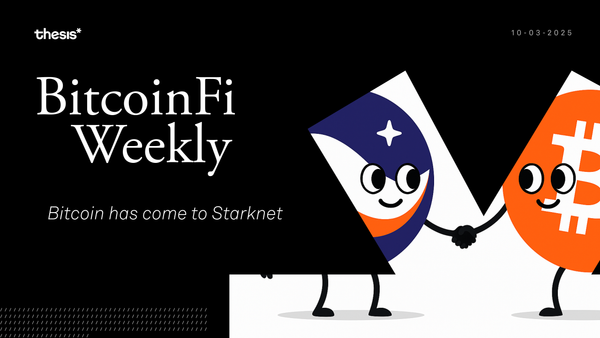Restaking, Ordinals Drama, & BitVM20 Dreams
Restaking is making its mark on Bitcoin, and the Ordinal controversy is causing quite a stir. Meanwhile, MEV is evolving, pushing new boundaries, and Fractal Bitcoin just went live, kicking up its own cloud of dust.

Welcome to BitcoinFi Weekly. We cover where people use their BTC and what is changing in the Bitcoin world.
As Bitcoin weathers yet another storm of volatility, seasoned Bitcoiners stand unfazed. Born in the caves of volatility, they’ve been through every storm, crash, and panic. They were built for this. So, when the market starts convulsing again, when the price dips, when the bears come howling at the door, the real Bitcoiners don’t flinch. They don’t run. They sit back, pour a drink, and light a cigarette, knowing damn well that this too shall pass. Sure, the price will move like a drunken barfly, staggering from one end of the night to the other. But while that mess unfolds, something bigger is always brewing in the background. That’s where the real action is—the quiet, relentless progress that doesn’t care about charts or market sentiment.
While the noise rages on this week, we’re getting into the real stuff. Restaking is making its mark on Bitcoin, and the Ordinal controversy is causing quite a stir. Meanwhile, MEV is evolving, pushing new boundaries, and Fractal Bitcoin just went live, kicking up its own cloud of dust. And if that wasn’t enough, fixed yield for Bitcoin is now on Pendle, giving the faithful a way to lock in returns, rain or shine.
It's a circus out there, grab a seat.
Here’s this week’s rundown:
📌 Featured Piece: Bitcoin Embraces Restaking
🔍 Ordinal Origins
⚙️ Bitcoin’s MEV Evolution
💠 BitVM20 Adds Fungibility to Bitcoin
🚀 Fractal is Live
💰 BTC Yield on Pendle
Feature Piece: Bitcoin Embraces Restaking
Within the last year or so, restaking has quickly taken the Ethereum ecosystem by storm, offering users a way to earn additional rewards by securing multiple dapps with their staked assets. While its rise in Ethereum was fueled by the natural extension of staking mechanisms in a PoS network, it didn’t take long for folks to find a way to implement restaking on Bitcoin.
Restaking first gained traction through protocols like EigenLayer, allowing validators to restake their staked ETH for additional rewards. However, Bitcoin’s entrance into this space poses unique challenges and opportunities. Unlike Ethereum, which operates under a PoS mechanism, Bitcoin uses PoW, meaning restaking on Bitcoin needs to be done through external PoS networks. BitcoinFi tools like tBTC and WBTC allow users to get their Bitcoin to PoS systems.
A new wave of Layer 2 solutions has emerged to overcome these hurdles. These protocols aim to expand Bitcoin's capabilities without compromising its fundamental properties. By processing transactions off the main Bitcoin blockchain, these solutions seek to increase transaction throughput and reduce fees, making Bitcoin more viable for DeFi applications. Currently, the top six Bitcoin Layer 2 solutions boast a combined total value locked (TVL) of approximately $1.03 billion. While this figure is substantial, it pales compared to Ethereum's more mature Layer 2 ecosystem, suggesting significant room for growth in the Bitcoin space.
A prime example is Lombard (a Bitcoinfi project built on Babylon), which has raised $16 million. Babylon allows Bitcoin holders to stake their BTC to secure other PoS networks, effectively extending Bitcoin’s utility. To mitigate Bitcoin's liquidity concerns, Lombard introduced "liquid bitcoin" tokens (LBTC), which enable Bitcoin holders to stake their assets without sacrificing liquidity.
Lombard and Babylon aren’t the only ones venturing into restaking. In fact, it’s already become quite a crowded space. The competitive landscape is intensifying as more players enter the Bitcoin restaking arena. Protocols like BounceBit, which has achieved a TVL of $221.2 million since its May launch, are gaining traction. Similarly, Core has seen rapid growth following the launch of Pell, a Bitcoin restaking protocol that now accounts for over 40% of Core's TVL.
Despite the enthusiasm, some questions remain about Bitcoin’s suitability for restaking compared to Ethereum. With a capped supply of 21 million coins and its established role as a store of value, Bitcoin is less prone to inflationary pressures than ETH, making it a more stable form of collateral for staking. However, Ethereum’s built-in staking mechanisms and flexibility within DeFi give it a practical edge in restaking, especially for protocols seeking more dynamic financial applications. Bitcoin's role in restaking is more aligned with enhancing security for PoS chains rather than being deeply integrated into DeFi ecosystems, where Ethereum has an advantage. The regulatory implications of these new financial products also loom large. As BitcoinFi grows, it will attract increased scrutiny from regulatory bodies worldwide.
Despite these hurdles, the entry of Bitcoin into restaking represents a significant advancement for BitcoinFi. Restaking represents a new chapter in Bitcoin’s ongoing evolution, and its success could reshape how BitcoinFi is perceived at large.
BitcoinFi Updates
Ordinal Origins
The rise of Ordinals has stirred considerable attention recently. At the center of this controversy is who can rightfully claim to be the creator or co-founder of the project.
At its core, Ordinals combine several elements: ordinal numbers for tracking satoshis, inscriptions for attaching NFT-like data to those satoshis, and runes, a lesser-known aspect of the protocol. The system is implemented through an open-source program called ord, which was designed to enable the creation and transfer of these digital assets on Bitcoin’s base layer.
The inception of Ordinals can be traced back to late 2021, when Casey Rodarmor, the primary developer, had the idea of creating NFTs on Bitcoin. Initially, the project was called "bitcoin-atoms," based on an early concept that involved creating "atoms" in every block. However, through discussions with collaborators such as Eric Sirion and Jeremy Rubin, the concept evolved into what is now known as Ordinals. By January 2022, the project had transitioned to its current form, with the repository renamed to “ord.”
The controversy primarily revolves around the role of an individual known as Rocktoshi. While Rodarmor acknowledges a prior friendship with Rocktoshi and his presence in early Discord discussions, he firmly states that Rocktoshi did not contribute meaningfully to developing the Ordinals protocol or its core ideas. There is no dispute that Rocktoshi co-founded the short-lived Ordinals Corporation, a startup created in early 2023. However, the extent of his contributions to the protocol remains a contention. Despite being a co-founder of the startup, the company had no direct impact on developing the Ordinals protocol and was dissolved within months of its formation. The situation escalated when Rocktoshi allegedly demanded significant compensation and continued to make threats and demands even after the dissolution of the company.
As the disputes surrounding Ordinals continue to unfold, they have had tangible effects on the broader market. The turmoil led to NodeMonkes, a collection of Ordianals, dropping below 0.1 BTC for the first time since their launch.
Bitcoin’s MEV Evolution
In our tBTC Issue, we explored and predicted the rising demand for block space driven by innovations such as Ordinals and Runes, alongside the paradox of declining miner profitability. This dichotomy of high demand and low rewards has opened the door for MEV as a potential solution for miners seeking new revenue streams. This shift is particularly notable given Bitcoin's 10-minute block time, which exacerbates the potential for MEV by providing a larger window for transaction manipulation. Within this extended timeframe, the Replace-by-Fee (RBF) mechanism becomes a powerful tool for MEV strategies.RBF allows users and potential MEV extractors to replace pending transactions with higher-fee versions, creating a dynamic fee market within each block interval. This mechanism, combined with the longer block time, enables more sophisticated bidding wars for transaction inclusion, potentially increasing miner revenues but raising transaction costs for users. The Child-Pays-for-Parent (CPFP) technique further complicates this landscape. As users leverage CPFP to expedite important transactions stuck in the congested mempool, miners must now consider entire transaction chains when optimizing block composition. This adds another layer of complexity to MEV extraction, as the value of including a low-fee parent transaction might be offset by a high-fee child transaction.
Moreover, the growing ecosystem of Bitcoin L2s introduces new vectors for MEV. Take Lightning for example: channel opening and closing transactions on the main chain become prime targets for fee sniping and other MEV strategies. The interaction between on-chain and off-chain activities creates a complex web of value extraction opportunities that span multiple layers of the Bitcoin stack.
As miners grapple with declining profitability, these aspects of Bitcoin will become critical levers for revenue optimization. The ability to efficiently manage the mempool, leverage RBF and CPFP, and navigate the new transaction types introduced by Ordinals and Runes is becoming as important as raw hash power in determining mining profitability.
BitVM20 Adds Fungibility to Bitcoin
BitVM propels itself back into the mindshare, as a new paper proposes the BitVM20 protocol. This new token standard for Bitcoin aims to introduce a fungible token standard on Bitcoin by utilizing the concepts of BitVM.Like BitVM, BitVM20 employs minimal on-chain computation, relying instead on off-chain validation by an operator and a decentralized network of verifiers. This approach allows for efficient transaction verification, with fraud detection as a fail-safe mechanism that only activates when inconsistencies are detected. The system is designed to bring more programmability and smart-contract functionality to Bitcoin, expanding its use cases.
At its core, BitVM20 draws its structure from the well-established ERC-20 standard on Ethereum, but adapts the protocol to fit within the constraints and architecture of Bitcoin. This includes leveraging the UTXO model and Bitcoin scripts for transaction validation, albeit with significant modifications. The system uses the BN254 elliptic curve for cryptographic signing and Blake3 for hashing.
One of the key components of BitVM20 is the reliance on an operator-verifier model, where a single operator manages a queue of transactions and the merkle tree state that holds user balances. Verifiers ensure the correctness of the transactions by tracking the operator’s broadcasts, generating necessary execution scripts, and ultimately signing off on transactions. This system is underpinned by an assumption that as long as at least one verifier remains honest, the protocol will function as intended. If fraud is detected, verifiers can lock the operator’s funds and prevent malicious activities.
By enabling fungible token creation and management, BitVM20 could seriously catalyze the development and proliferation of BitcoinFi. We live in exciting times.
Fractal is Live
A few weeks ago, we explored Fractal, a new protocol designed to build multiple layers on top of Bitcoin to address network congestion and enhance performance. Unlike traditional Layer 2 solutions, Fractal aims to enable a limitless stack of layers on Bitcoin. On September 9, Fractal officially launched its mainnet, but the debut was not without complications.
The launch has been met with both excitement and criticism. Analysis of the project reveals that Fractal appears to be largely based on Bitcoin Core v24.0.1, with some modifications and elements borrowed from other cryptocurrencies like Namecoin and Bitcoin Cash. These changes include a faster block time of 30 seconds, a continuous difficulty adjustment mechanism, and a supply cap of 210 million coins, double Bitcoin’s limit. The project’s most contentious aspect is its 50% premine, giving the team immediate access to a large portion of the total supply. This premine structure has raised concerns about centralization.
Despite these concerns, the Fractal launch has drawn significant interest from Bitcoin miners, particularly from major Asian pools such as Antpool, F2Pool, and Spiderpool. About one-third of Bitcoin’s hashpower, around 200 EH/s, has been directed toward Fractal’s merge-mining process.
Key features of Fractal include:
- A hybrid consensus mechanism combining standard Proof of Work and merge-mined blocks
- A faster block time of 30 seconds, compared to Bitcoin's 10 minutes
- Continuous difficulty adjustment, similar to Bitcoin Cash
- A maximum supply of 210 million coins, ten times that of Bitcoin
- An initial block reward of 25 coins, with halvings every 2.1 million blocks
- The activation of OP_CAT
The economic implications of Fractal’s launch are still unfolding. Early estimates suggest that Bitcoin miners could see a modest 1% increase in daily revenue from mining Fractal Bitcoin, generating around $300,000 in additional income per day. However, Fractal’s token, $FB, is still undergoing price discovery, and liquidity is thin across the handful of markets where it is traded. This makes it uncertain whether miners will be able to realize these gains or if the speculative value of $FB will hold in the long term.
BTC Yield on Pendle
BitcoinFi enjoyooooors can now earn fixed yield on their assets through Pendle’s eBTC offering. Unlike typical floating yields, Pendle’s 6.9% APY on PT-eBTC provides stability, allowing users to lock in returns without worrying about market fluctuations.
The mechanics of PT-eBTC are quite straightforward. Each PT-eBTC token is equivalent to one eBTC at maturity, which is set for December 26, 2024. Given that PT-eBTC is priced lower than eBTC, investors can acquire more PT-eBTC now, potentially resulting in a larger eBTC holding when the tokens mature. This structure offers a unique opportunity for Bitcoin holders to grow their BTC stack with a fixed, predictable rate of return.
The offering is part of a broader collaboration between ZeroLend, Pendle, and EtherFi, allowing users to earn various points. An advanced strategy involving minting PT and YT on Pendle, swapping YT for PT, supplying PT as collateral on ZeroLend, and borrowing eBTC allows users to potentially maximize their yields and points earnings across these platforms.
Closing Thoughts
Bitcoiners are no strangers to rough waters. They’ve weathered every storm and know that the road ahead, while uncertain, always leads forward. The markets will rise and fall, just as they have before, but the real progress happens in the moments between—where innovation thrives quietly, pushing boundaries and building toward something stronger. As restaking reshapes the landscape, Ordinals spark debate, and Fractal Bitcoin makes waves, Bitcoiners stay the course, unfazed by the noise. Through it all, they know that the path remains clear. Storms pass, but Bitcoin endures.
Thank you for tuning in to this week’s BitcoinFi Weekly. See you next week.
If there's a topic you’d like us to cover or have questions, reach out at [email protected].
Learn more about Mezo at the following channels:
👾 Discord: https://discord.mezo.org
🕊 X: https://twitter.com/MezoNetwork
🖥 Website: https://mezo.org
🏦 Deposit Portal: https://mezo.org/hodl
ℹ️ Docs: https://info.mezo.org





